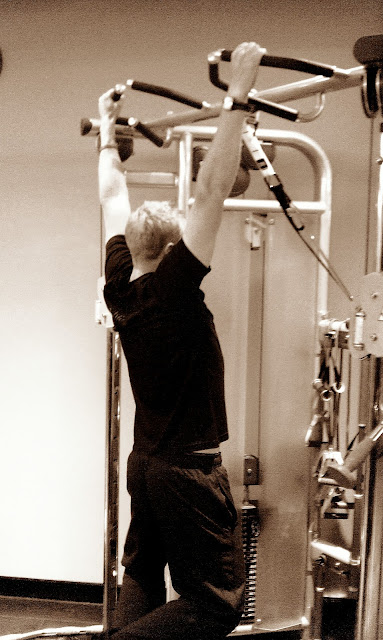The Chin Up is perhaps the best exercise for back strength and a great indication of total body strength. Performed correctly, the exercise mainly utilises the Latissimus Dorsi, but is assisted by the Biceps, Rhomboids and Trapezius muscles. On their own, the Lats are an extremely large muscle; they attach onto the vertebrae (T6 to the sacrum), the pelvis, the ribs, the scapula and the humorous. They make up most of the muscle mass that you see when you look at someone’s back and therefore play a huge role in back health and mobility. The Lats work to help depress the scapula - so if you sit at a desk all day staring at a computer and as a result suffer from a forward head posture and kyphosis (rounding of the shoulders), then chin ups could be the way forward for you.
Now, as a beginner, I would not rush straight into Chin Ups, they are a hard exercise and usually require a decent amount of training just to be able to achieve your first repetition. I get my clients to start with mobilisation exercises, such as wall slides and bands rows, to allow the shoulder to achieve a full range of motion before we start to add weight.
Once you have good shoulder mobility, you need to start looking at scapular control. More often than not in an untrained person, the level of control that they have over scapular movement is very low. The scapula becomes fixed in one position or is permanently rotated away from the natural position, close to the medial line of the body. I choose to use pulling or rowing exercises, such as single arm dumbbell rows and cable rows, to help correct scapula control and to start increasing strength in the shoulder girdle.
You should now have a fairly healthy shoulder and are ready to start your training to achieve that first chin up repetition. For novice clients, I start with exercises such as lat pulldowns, so that they can start to groove the type of movements that they will need for the chin up. Once the weight starts getting up to around 75% of the clients’ bodyweight, I will start to add in assisted chin ups. For the assistance, I try to stay away from the specifically designed chin up machines that support your bodyweight. They can alter the position of the body during the eccentric phase of the exercise and reduce the focus of the exercise from the Lats more towards the shoulders and bicep. Instead, I use bands or a cable machine with a jacket to assist the client when first performing Chin Ups. This allows for a more natural movement and for the client to begin understanding how to perform the exercise with good form. Once the client has achieved the desired set and rep range, we can then move onto full chin ups.
To perform a full Chin Up with good form and a full range of motion requires a great deal of mental toughness. You need to be able to activate your Lats so that they perform the bulk of the work; this is difficult in itself as most people do not have the ability to recruit specific muscle groups for a specific action. To help increase activation you can use a physical cue, either someone putting pressure on the muscle you want to activate during the exercise or by doing it yourself before performing the exercise. This cues the brain and helps to develop a link between the muscle and the brain that will then be associated with the exercise.
A chin up can either be started from the flexed position with the concentric phase first or from the extended position with the eccentric phase first. Either way, proper form is essential. I prefer to start with the eccentric phase first as this is the weakest park of the movement. To begin, grip the bars or the handle with whatever grip is most natural and comfortable for you. Supinated, semi-supinated, pronated or mixed grip, it does not really matter. Whatever feels natural is most likely to reduce the risk of injury so that is what I believe you should go with. Lower yourself so that your elbows are fully extended and so that your shoulders are completely relaxed and extended. This is your starting position. From this position you want to move as quickly as you can through the phase to the flexed position, elbows flexed, shoulders adducted and scapula depressed. This is where it is important to concentrate on using the Lats so that you get the most out of the exercise. At the top of the movement, pause for a second and then begin to lower yourself down again. For maximum strength gains this phase should take between 2 – 4 seconds, as we are normally stronger during the eccentric phase of a motion we can increase the time under tension to maximise strength gains.
Again, once the repetition and set range has been achieved, we can start to add weigh on top of the natural bodyweight of the client.




This allows for a more natural movement and for the client to begin understanding how to perform the exercise with good form. Once the client has achieved the desired set and rep range, we can then move onto full chin ups.
ReplyDeletehttps://www.rx247.net